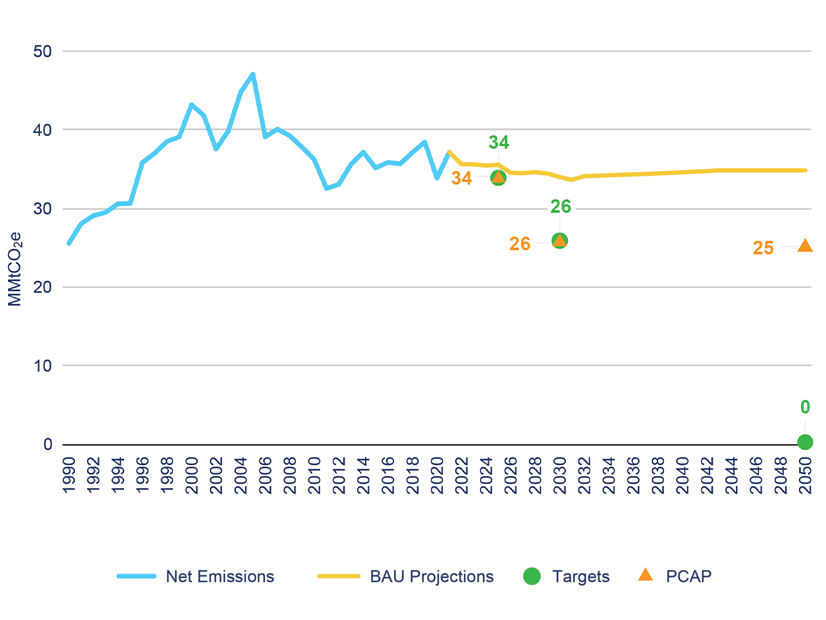
Nevada has released a draft climate action plan that lays out steps the state can take quickly to move toward greenhouse gas reduction goals.
The Nevada Division of Environmental Protection (NDEP) received a $3 million federal grant to develop the strategy, known as the Priority Climate Action Plan (PCAP). NDEP released a draft PCAP on Feb. 15; public comments will be accepted through Feb. 22.
The plan lists a wide array of priority actions grouped into six focus areas. Among priority actions within the transportation focus area are incentives to electrify government and large commercial vehicle fleets, and rebates for the purchase of zero-emission vehicles (ZEVs) or electric bikes.
Developing infrastructure for medium- and heavy-duty ZEVs is another priority, as is updating and expanding the state’s EV charging plan under the National Electric Vehicle Infrastructure (NEVI) program.
Under the energy system focus area, the plan proposes incentives such as grants for developing clean energy hubs at former mining sites or brownfields.
In addition to transportation and energy systems, the plan’s other four focus areas are buildings, industry, waste reduction, and landscape restoration and carbon sequestration.
“The primary objective is to identify near-term, high-priority, implementation-ready measures to reduce GHG emissions,” the plan states.
Implementation Grants
The PCAP is just the first phase of planning funded by the $3 million federal grant. The funding, from EPA’s Climate Pollution Reduction Grant (CPRG) program, will also cover NDEP’s development of a more in-depth Comprehensive Climate Action Plan (CCAP).
In addition to money for planning, the CPRG will offer $4.6 billion for implementation of GHG-reduction measures included in a PCAP. States have a March 1 deadline for submitting a PCAP; applications for implementation grants are due April 1.
Nevada set greenhouse gas reduction targets through Senate Bill 254 in 2019. The state is aiming for a 28% reduction in GHG emissions by 2025 relative to 2005 levels; a 45% reduction by 2030; and zero or near-zero emissions by 2050.
But Nevada’s 2023 Greenhouse Gas Inventory has projected that GHG emissions will fall short of the reduction targets, with a 24.5% reduction in 2025 and a 27.8% reduction in 2030.
The PCAP projects a 48.2% reduction in 2050.
By implementing measures in the PCAP, Nevada could meet the 2025 and 2030 targets but would still come up short of the 2050 goal, the plan said.
“Meeting 2050 goals will require additional measures, to be described in the CCAP,” the draft plan said.
NDEP’s release of the draft PCAP comes after Gov. Joe Lombardo (R) last year ordered an overhaul of Nevada’s 2020 climate strategy to reflect his energy policies. Lombardo defeated the incumbent governor, Democrat Steve Sisolak, in the November 2022 election. (See New Governor Seeks Shift in Nevada Energy Policy.)
Among policies in Lombardo’s March 2023 executive order was direction to meet the state’s energy demands with a diverse portfolio including solar, wind, geothermal, natural gas, storage and other resources.
In contrast, the state’s 2020 Climate Strategy called for transitioning away from natural gas to meet the 2050 net-zero emissions goal. A link from NDEP’s website to the 2020 Climate Strategy now goes to a page reading “under construction.”
NDEP applied for the CPRG planning grant in April 2023 and was awarded the funds in June.
Neither the PCAP nor CCAP are intended to replace the 2020 Nevada Climate Strategy, an NDEP spokesperson told NetZero Insider. But the technical work and outreach for the two plans will help during revisions of the climate strategy.
“Currently NDEP’s efforts are focused on the CPRG to ensure that Nevada is well positioned to apply for and secure the unprecedented level of federal funding for the implementation of emissions reduction projects in Nevada,” the spokesperson said in an email.
Most-emitting Sectors
Nevada’s 2023 GHG inventory includes emissions data from 1990 through 2021 and projections through 2043. In 2021, the state emitted 37.2 million metric tons (MMT) of CO2 equivalent — 21% less than the peak of 47.1 MMT in 2005.
The transportation sector was the leading contributor to GHG emissions in 2021, accounting for 34% percent of the total. Electricity generation and industry followed, with 30% and 16% of the total, respectively.
Before 2015, electricity generation was the largest source of the state’s GHG emissions, with transportation in second place.
The PCAP notes the strong prospects for clean energy projects in Nevada, where the technical potential is 6.27 billion MWh for commercial, residential and utility solar; 1.13 billion MWh for wind; and 54 million MWh for geothermal.
“This dwarfs annual electricity consumption, which was approximately 39 million MWh in 2021,” the PCAP said. “Based on this, renewable electricity generated in Nevada could supply the state’s annual electricity needs multiple times over.”
